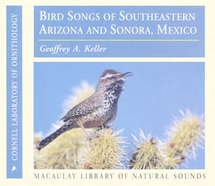Reviewed by Grant McCreary on December 24th, 2008.
Birding products are becoming more regionally focused, moving from a continent/country-wide scale down to the state level, or even finer. This has happened to field guides, bird-finding guides, and now collections of bird vocalizations. This two CD set, produced by the Cornell Lab or Ornithology, focuses specifically on the birds that can be found in the birding mecca of southeastern Arizona, and the neighboring Mexican state of Sonora.
The songs and calls of 202 species are presented here. The format is familiar: just about every track features one species; the species name is announced at the beginning and is followed by a series of songs and calls. Due to the limitations of the CD format, seven tracks pull double duty and contain two species. Each track is about 45 seconds long, on average.
The entire first CD and the first 44 tracks of the second are “southeastern Arizona birds”. These have had at least one confirmed breeding record in the state. The remaining 51 tracks comprise the Sonoran birds. However, several of these Sonoran birds are more-or-less regular vagrants to the ABA area, and some have recently bred, such as Rufous-capped Warbler. Each of these two groupings is presented in taxonomic order.
The audio quality is fantastic, as would be expected of recordings from Cornell’s Macaulay Library of Natural Sounds. There is a little background noise, such as other birds, but it is not too loud or distracting. The featured sounds always come through loud and clear.
This set comes with a useful booklet that lists all of the tracks, describes the songs and calls contained in each track, and mentions where it was recorded. The descriptions are very valuable, as they point out what to listen for in the vocalizations, how they may differ from similar sounds, and other helpful information.
These CDs would obviously serve you well in Sonora, but they are also essential for SE Arizona. “But”, you may be thinking, “I’ve got both of the Stokes CD sets. Why would I need another collection for just this one spot?” It is a valid question. Honestly, for most places in the ABA area I would argue that you probably do not need anything else. However, in this case I think there is sufficient reason to supplement your library of bird songs with this set. First, I must note that this collection is not intended to be a replacement of, but rather a supplement to, the Stokes sets (or other sound collection of your choice). Since it focuses on the specialties of this region, it does not contain some of the more widespread species, such as the Great Horned Owl.
To understand how this collection can help you, imagine if you will the following scenario. You’re birding southeastern Arizona for the first (or even second or third) time. You’re at a well-known hotspot when you hear an unfamiliar song. That’s not extremely surprising, but it’s nothing like any song you listened to while preparing for this trip. You figure that it could be some eastern vagrant, probably a warbler since you don’t know their songs very well. You spend many fruitless minutes trying to find the songster, but you decide to continue on your way, mystery unsolved. It would be cool to see, of course, but it’s not why you came here. After all, there are still plenty of true Arizona specialties waiting to be found.
A couple of days later, you read about an amazing discovery on the Arizona listserv. Some birders have found an unexpected Mexican bird (a first for the ABA area!) at the same hotspot you just birded. They managed to see and even photograph the vagrant, but it was the song that initially clued them into its presence. On a hunch, you listen to the song. That’s it! That’s the song that you heard! Excitement over a mystery solved turns to dejection when you realize that you let an incredible lifer slip through your fingers. (Depending on how one feels about heard-only birds, you could justifiably add this one to your life list. But you want to see all of your birds.) What could be worse? Just this: the dawning realization that you not only missed a life bird, but the chance to be the one to discover a bird never before seen in the ABA area.
Seem farfetched? Probably, except for the fact that it actually happened. In this case, it was the Sinaloa Wren at SE Arizona’s Patagonia-Sonoita Creek Preserve in August 2008. I have spoken to a birder who heard the bird several days before it was identified, but did not realize what it was. As I’m sure you’ve already guessed, Sinaloa Wren is included in this set.
This compilation includes over a dozen vagrants and rarities that have occurred in Arizona and are not found on the Stokes sets. And there are many more potential vagrants from Sonora, such as the aforementioned wren, that could show up at any time. I only noticed one specialty that was missing, the Aztec Thrush.
Recommendation
No one birding southeastern Arizona or Sonora should be without this audio guide from Cornell. It includes a significant number of specialties not found in more general collections. And who knows what else you might find? Laughing Falcon, anyone?
Track Listing
- Track Order
- Alphabetical (pdf from ABA Sales)
You can order this directly from Cornell or from ABA Sales. The birdJam people also have an add-on module that you can use to add these tracks to your ipod.
Disclosure: I get a small commission for purchases made through links in this post.
Disclosure: The item reviewed here was a complementary review copy provided by the publisher. But the opinion expressed here is my own, it has not been influenced in any way.



Comment